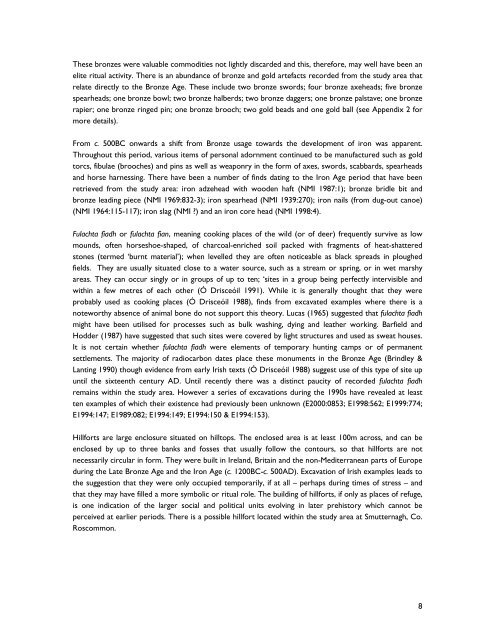archaeological & built heritage assessment - The Heritage Council
archaeological & built heritage assessment - The Heritage Council
archaeological & built heritage assessment - The Heritage Council
Create successful ePaper yourself
Turn your PDF publications into a flip-book with our unique Google optimized e-Paper software.
<strong>The</strong>se bronzes were valuable commodities not lightly discarded and this, therefore, may well have been an<br />
elite ritual activity. <strong>The</strong>re is an abundance of bronze and gold artefacts recorded from the study area that<br />
relate directly to the Bronze Age. <strong>The</strong>se include two bronze swords; four bronze axeheads; five bronze<br />
spearheads; one bronze bowl; two bronze halberds; two bronze daggers; one bronze palstave; one bronze<br />
rapier; one bronze ringed pin; one bronze brooch; two gold beads and one gold ball (see Appendix 2 for<br />
more details).<br />
From c. 500BC onwards a shift from Bronze usage towards the development of iron was apparent.<br />
Throughout this period, various items of personal adornment continued to be manufactured such as gold<br />
torcs, fibulae (brooches) and pins as well as weaponry in the form of axes, swords, scabbards, spearheads<br />
and horse harnessing. <strong>The</strong>re have been a number of finds dating to the Iron Age period that have been<br />
retrieved from the study area: iron adzehead with wooden haft (NMI 1987:1); bronze bridle bit and<br />
bronze leading piece (NMI 1969:832-3); iron spearhead (NMI 1939:270); iron nails (from dug-out canoe)<br />
(NMI 1964:115-117); iron slag (NMI ?) and an iron core head (NMI 1998:4).<br />
Fulachta fiadh or fulachta fian, meaning cooking places of the wild (or of deer) frequently survive as low<br />
mounds, often horseshoe-shaped, of charcoal-enriched soil packed with fragments of heat-shattered<br />
stones (termed ‘burnt material’); when levelled they are often noticeable as black spreads in ploughed<br />
fields. <strong>The</strong>y are usually situated close to a water source, such as a stream or spring, or in wet marshy<br />
areas. <strong>The</strong>y can occur singly or in groups of up to ten; ‘sites in a group being perfectly intervisible and<br />
within a few metres of each other (Ó Drisceóil 1991). While it is generally thought that they were<br />
probably used as cooking places (Ó Drisceóil 1988), finds from excavated examples where there is a<br />
noteworthy absence of animal bone do not support this theory. Lucas (1965) suggested that fulachta fiadh<br />
might have been utilised for processes such as bulk washing, dying and leather working. Barfield and<br />
Hodder (1987) have suggested that such sites were covered by light structures and used as sweat houses.<br />
It is not certain whether fulachta fiadh were elements of temporary hunting camps or of permanent<br />
settlements. <strong>The</strong> majority of radiocarbon dates place these monuments in the Bronze Age (Brindley &<br />
Lanting 1990) though evidence from early Irish texts (Ó Drisceóil 1988) suggest use of this type of site up<br />
until the sixteenth century AD. Until recently there was a distinct paucity of recorded fulachta fiadh<br />
remains within the study area. However a series of excavations during the 1990s have revealed at least<br />
ten examples of which their existence had previously been unknown (E2000:0853; E1998:562; E1999:774;<br />
E1994:147; E1989:082; E1994:149; E1994:150 & E1994:153).<br />
Hillforts are large enclosure situated on hilltops. <strong>The</strong> enclosed area is at least 100m across, and can be<br />
enclosed by up to three banks and fosses that usually follow the contours, so that hillforts are not<br />
necessarily circular in form. <strong>The</strong>y were <strong>built</strong> in Ireland, Britain and the non-Mediterranean parts of Europe<br />
during the Late Bronze Age and the Iron Age (c. 1200BC-c. 500AD). Excavation of Irish examples leads to<br />
the suggestion that they were only occupied temporarily, if at all – perhaps during times of stress – and<br />
that they may have filled a more symbolic or ritual role. <strong>The</strong> building of hillforts, if only as places of refuge,<br />
is one indication of the larger social and political units evolving in later prehistory which cannot be<br />
perceived at earlier periods. <strong>The</strong>re is a possible hillfort located within the study area at Smutternagh, Co.<br />
Roscommon.<br />
8
















